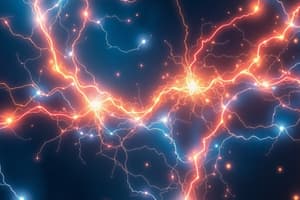Podcast
Questions and Answers
What type of current does a dry cell produce?
What type of current does a dry cell produce?
- Variable current
- Pulsating current
- Alternating current
- Direct current (correct)
Which of the following statements about primary cells is true?
Which of the following statements about primary cells is true?
- They produce current from reversible reactions.
- They become useless once the chemical energy is depleted. (correct)
- They are always larger than secondary cells.
- They can be recharged multiple times.
What component of a cell changes chemical energy to electrical energy?
What component of a cell changes chemical energy to electrical energy?
- Current
- Electrodes
- Chemical reactions (correct)
- Electrolyte
What is the primary difference between primary and secondary cells?
What is the primary difference between primary and secondary cells?
In a direct current system, how does the current flow?
In a direct current system, how does the current flow?
Flashcards
Direct Current (DC)
Direct Current (DC)
A current with constant magnitude that flows in one direction.
Primary Cell
Primary Cell
A type of cell that generates current by irreversible chemical reactions and cannot be recharged. Examples include Leclanche cells and dry cells.
Secondary Cell (Accumulator)
Secondary Cell (Accumulator)
A type of cell that can be recharged and used repeatedly. These cells store electrical energy.
Electrodes
Electrodes
Signup and view all the flashcards
Electrolyte
Electrolyte
Signup and view all the flashcards
Study Notes
Current Electricity
- Simple electric circuits use cells and bulbs to demonstrate current, charge, and potential difference. Insulators and conductors are key components of closed and open circuits. Electron flow direction is important.
- Current electricity involves brief introductions to sources, such as cells and accumulators, and their construction and operation.
- Current is the rate of charge flow; symbols and circuit diagrams are crucial. Detecting current uses galvanometers or ammeters.
- Resistance components like wires and resistance boxes are used in circuits, and potential difference (V) is defined as work per unit charge (W/q).
- Ohm's Law (V = IR) links voltage, current, and resistance. Insulators and conductors are integral to these concepts.
- Efficient use of energy is important within the scope of social initiatives and eco-friendly technologies.
Electric Current
- Cells convert chemical energy into electrical energy when a circuit is closed.
- A cell structure consists of a vessel with two electrodes immersed in an electrolyte.
- Electrodes are conducting rods, and electrolytes are solutions (or jelly).
- Cells are categorized into Primary Cells (non-rechargeable) and Secondary Cells (rechargeable, accumulators).
- Primary cells, such as dry cells, work through irreversible chemical reactions. Their energy is used once, and they are discarded after use.
- Types of primary cells include Leclanche cells and dry cells.
Studying That Suits You
Use AI to generate personalized quizzes and flashcards to suit your learning preferences.




